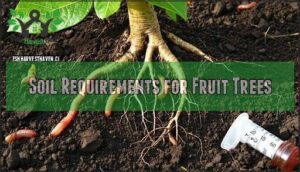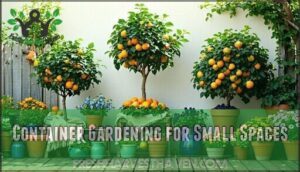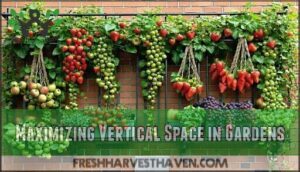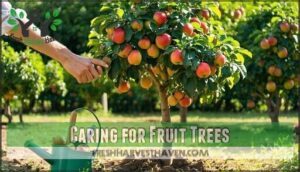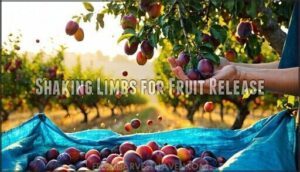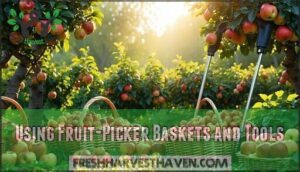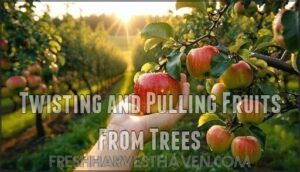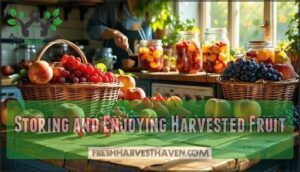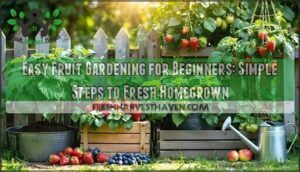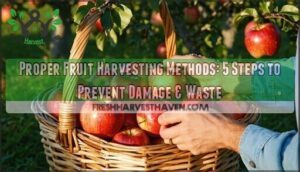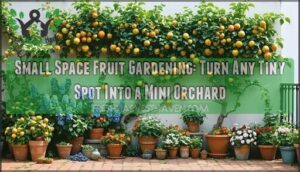This site is supported by our readers. We may earn a commission, at no cost to you, if you purchase through links.
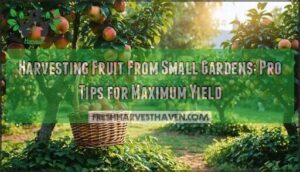 You’ll master harvesting fruit from small gardens by timing it right.
You’ll master harvesting fruit from small gardens by timing it right.
Pick apples when they twist off easily, and grab peaches when they give slightly to gentle pressure.
Use fruit-picker baskets to reach high branches without damaging delicate fruits.
Check your trees daily during harvest season – overripe fruit attracts pests and spoils quickly.
Store your bounty in cool, dry places to extend freshness.
Even tiny gardens can produce bushels of homegrown goodness when you know the tricks that turn novice gardeners into fruit-harvesting pros.
Table Of Contents
- Key Takeaways
- Choosing Fruit Trees
- Preparing Small Gardens
- Caring for Fruit Trees
- Harvesting Fruit Techniques
- Storing and Enjoying Harvested Fruit
- Frequently Asked Questions (FAQs)
- How to tell when fruit is ready to harvest?
- What is the easiest fruit to harvest?
- How to harvest from your garden?
- What are the best fruits for small gardens?
- What is the best stage of harvesting fruits?
- How can you tell if a fruit is ready for harvest?
- Which fruit tree is best for a small garden?
- How do you pick fruit from the ground?
- What fruits cannot be planted together?
- What are the best times to harvest fruit?
- Conclusion
Key Takeaways
- Time your harvest perfectly – You’ll get the best flavor and shelf life by picking fruit when it gives slightly to gentle pressure, twists off easily, and develops its characteristic sweet aroma.
- Choose dwarf varieties for maximum yield – You can grow full-sized fruit in compact spaces using dwarf trees that reach only 6-10 feet tall but still produce 40-70 pounds annually.
- Use proper tools and techniques – You’ll prevent damage and reach high branches safely with fruit-picker baskets, gentle twisting motions, and early morning harvesting when temperatures are cool.
- Store correctly to extend freshness – You’ll keep your harvest fresh longer by storing fruit at 32-40°F with 85-95% humidity and separating ethylene-producing fruits like apples from sensitive varieties.
Choosing Fruit Trees
Selecting the right fruit trees for your small garden starts with understanding your space and climate needs.
You’ll want to take into account dwarf and semi-dwarf varieties that produce full-sized fruit without overwhelming your garden, while ensuring they can thrive in your local growing conditions.
Dwarf Fruit Tree Varieties
Beyond the confines of traditional orchards, Dwarf Apples like ‘Honeycrisp’ and ‘Gala’ transform your small garden into a fruit-producing paradise.
Small spaces, big harvests – dwarf varieties deliver full-sized fruit without the towering footprint.
These compact trees reach just 6-10 feet tall, delivering full-sized harvests without the towering height.
Miniature Peaches such as ‘Bonanza’ grow 4-6 feet, perfect for patios. Dwarf Cherries like ‘Stella’ stay under 10 feet and self-pollinate. Container Blueberries thrive in pots, while Balcony Citrus trees like ‘Improved Meyer Lemon’ produce fruit within 2-3 years.
Thanks to specialized grafting, these dwarf fruit trees yield 40-70 pounds annually.
You’ll start harvesting in just 2-4 years versus 5-8 for standard varieties. Compact trees require only 8-12 feet spacing, making fruit harvesting manageable and rewarding in the smallest spaces.
Semi-Dwarf Fruit Tree Options
Semi-dwarf fruit trees strike the perfect balance between size vs. yield, delivering substantial harvests from manageable 12-15 foot trees. You’ll get more fruit than dwarf varieties while keeping maintenance simple.
Rootstock influence determines your tree’s final size and disease resistance, making these grafted gems ideal for small gardens. Most semi-dwarf fruit trees need pollination partners, so plan for compatible varieties.
For those with limited outdoor space, consider growing dwarf varieties indoors.
Here’s your semi-dwarf starter pack:
- Apple trees – yield 10-20 bushels annually with consistent harvests
- Peach trees – produce 50-150 pounds of fruit within 2-4 years
- Cherry trees – deliver 30-50 pounds yearly in compact spaces
These trees require 6-8 hours of sunlight needs daily and fit perfectly in 150-200 square feet. Training methods like espalier work beautifully with semi-dwarf varieties, maximizing your fruit harvesting potential in small gardens.
Climate Considerations for Tree Selection
When choosing fruit trees for small gardens, you’ll need to match varieties to your hardiness zones and microclimate effects.
Your backyard’s unique conditions—sun exposure, wind patterns, and frost pockets—determine which dwarf fruit trees and semidwarf fruit trees will thrive.
Regional varieties adapted to your climate considerations require specific chill hours to produce fruit.
Cold-hardy apples need 800-1,200 chill hours, while citrus thrives in warmer zones.
Consider frost protection for borderline varieties.
Your microclimate might allow growing trees from one zone warmer than your official rating.
Smart selection means reliable harvests from your compact growing space, leading to tasty success.
Preparing Small Gardens
Before you can harvest fruit from your small garden, you need to set up the right foundation for your trees to thrive.
Smart soil preparation, container choices, and space-saving techniques will determine whether you’ll be picking abundant fruit or wondering why your trees aren’t producing.
Soil Requirements for Fruit Trees
Your fruit trees’ success starts with soil that makes them thrive. After selecting the right varieties, you’ll need to create the perfect growing foundation.
Strong soil is the foundation of fruitful trees—get this right and everything else follows.
Soil pH between 6.0 and 6.5 keeps nutrients flowing to hungry roots. Most soil types work if you add organic matter like compost or aged manure. This boosts soil health and helps with drainage needs.
Soil testing reveals what your garden soil lacks. You can grab a simple kit from any garden center. Test results show if you need lime to raise pH or sulfur to lower it. Poor soil requirements lead to nutrient deficiency and weak trees.
Here’s your soil prep checklist:
- Test soil pH with a home kit or professional analysis
- Add 2-3 inches of compost to improve organic matter content
- Check drainage by digging a hole and filling with water
- Raise beds if water sits longer than 24 hours
- Mix amendments into top 12 inches of soil
Container Gardening for Small Spaces
After sorting out soil needs, let’s talk about container gardening for small gardens. Picking the right container size matters—dwarf varieties need sturdy pots, at least 20 gallons, for strong roots and healthy fruit trees.
Don’t skimp on potting mixes; use a blend with compost for nutrients. Good drainage solutions are key. Make sure your containers have holes so roots don’t sit in soggy soil. Consider purchasing dwarf trees for smaller spaces.
Container plants love sunlight. Most need 6-8 hours daily, so find a sunny spot. Watering needs change with the seasons, but keep soil consistently moist—not soaked or bone dry.
Here’s a quick look at popular options:
| Container Type | Best For |
|---|---|
| Ceramic pots | Dwarf citrus |
| Fabric containers | Berry bushes |
| Wooden planters | Apple trees |
Plastic pots work great for beginners—lightweight and easy to move. With smart container sizes and the right potting mixes, even the smallest patio can become a mini orchard.
Maximizing Vertical Space in Gardens
Smart gardeners know that vertical space is your secret weapon for maximizing harvests in cramped quarters.
Transform bare walls into productive growing areas with these space-saving strategies:
- Trellis fruit trees like grapes and kiwi against sturdy fence posts
- Wall-mounted planters create modular herb and strawberry gardens
- Espalier techniques train apple trees flat against sunny walls
- Hanging fruit baskets let berries cascade from balcony railings
- Climbing fruit varieties use tensioned wires for vertical support
This vertical garden design approach turns every surface into potential growing space.
Your small garden becomes a three-dimensional harvest zone that produces more fruit per square foot than traditional ground-level planting ever could.
Caring for Fruit Trees
Your fruit trees need consistent care to produce the best harvest possible.
Proper pruning, feeding, and pest control will keep your trees healthy and maximize your yield in even the smallest garden spaces.
Regular Pruning Techniques
Your tree’s health depends on mastering proper pruning techniques that boost fruit production while keeping dwarf varieties manageable.
Regular garden maintenance through strategic cuts creates stronger, more productive trees in small gardens.
Essential pruning techniques for maximum yield:
- Pruning Tools: Use sharp, clean bypass pruners for branches under 1 inch diameter
- Pruning Timing: Late winter dormancy prevents sap loss and disease entry points
- Shaping Techniques: Create open centers allowing sunlight to reach all fruit-bearing branches
- Branch Angle: Maintain 45-60 degree angles from trunk for strongest fruit-bearing limbs
- Wound Care: Make clean cuts just outside branch collar to promote proper healing
For ideal tool selection, consider various bypass pruners available.
Fertilization and Watering Schedules
Your tree’s nutrient timing sets the stage for abundant harvests.
Young trees need nitrogen-rich organic fertilizers in early spring, while mature ones require balanced feeding throughout the growing season.
Create a fertilization schedule based on your tree’s age and watch for deficiency symptoms like yellowing leaves.
Watering depth beats frequency—deep morning sessions encourage strong roots and boost soil moisture retention.
Check dampness two inches down with your finger.
Consistent watering schedules paired with proper fertilization transform small gardens into productive powerhouses.
Pest and Disease Management Strategies
Building a fortress against pests requires vigilance and strategy. Organic options give you powerful tools without harsh chemicals that harm beneficial insects.
Natural predators like ladybugs consume up to 5,000 aphids in their lifetime, while parasitic wasps target scale insects effectively. Prophylactic sprays with neem oil prevent fungal diseases before they establish. Fall cleanup removes overwintering pest hideouts that cause spring problems. To further protect your trees, consider employing insect netting as a physical barrier.
Your integrated pest management approach should include:
- Deploy beneficial insects and encourage bird habitats for natural pest control
- Apply preventive treatments before disease control becomes necessary
- Practice thorough sanitation by removing fallen leaves and damaged fruit
- Use fruit thinning to improve air circulation and reduce pest-friendly overcrowding
Regular pruning also improves airflow, reducing disease incidence by creating less humid microclimates around your trees.
Harvesting Fruit Techniques
When harvest time arrives, you’ll need to know the right techniques to gather your precious fruit without damaging the tree or bruising your harvest.
The methods you choose depend on your fruit type and tree height, but mastering these skills guarantees you get the most from your small garden investment, which is a valuable small garden consideration.
Shaking Limbs for Fruit Release
Shaking limbs releases fruit when timed right, but there’s more to it than giving branches a good rattle. Fruit ripeness determines success—you’ll get up to 85% better detachment rates when fruit hits peak ripeness.
Optimal timing matters too. Shake in early morning when temperatures are cooler. This reduces fruit damage by 30% since firmer fruit handles the motion better. Skip shaking after rain or during high humidity to prevent fungal issues.
Branch strength guides your technique. Stone fruits like plums and cherries respond best to limb shaking, releasing over 90% of fruit efficiently. Apples and pears need more force but risk 12% higher limb damage.
Keep your shaking rhythm controlled—short 5-10 second bursts work best. Your shaking frequency depends on the fruit type:
Lay tarps beneath trees to capture 95% of fallen fruit and prevent waste.
Using Fruit-Picker Baskets and Tools
When your arms can’t reach those high branches, fruitpicker tools become your best harvest companions.
These specialized tools extend your reach while protecting delicate fruit from damage.
Quality fruit picker tools feature:
- Telescoping poles for adjustable extended reach
- Padded baskets that prevent fruit damage during collection
- Lightweight construction for easy tool maintenance
- Durable materials like stainless steel and PVC coatings
- Ergonomic grips that reduce hand fatigue.
Different basket types suit various fruits—soft-padded versions work best for tender peaches, while wire baskets handle sturdy apples.
Remember ladder safety if you’re combining tools with climbing.
Regular tool maintenance keeps your fruitpicker baskets working smoothly season after season.
Understanding the role of ethylene can also help you determine the best time to harvest.
With proper fruit accessibility tools, you’ll harvest more efficiently while minimizing fruit damage.
Twisting and Pulling Fruits From Trees
Mastery comes through understanding each fruit’s unique harvesting needs. Different fruits require specific techniques for clean removal without damage.
Check for fruit ripeness signs before picking. Ripe fruit detaches easily with gentle pressure. Support the branch while twisting fruits upward, then pull downward at the proper fruit detachment angle. This prevents bark damage and guarantees clean stem separation.
Your gentle handling tips start with proper hand placement. Cup the fruit in your palm while your thumb and fingers grip near the stem. Avoid fruit damage by never yanking or forcing stubborn fruit—it’s not ready yet.
Here’s your quick reference guide:
| Fruit Type | Harvesting Technique |
|---|---|
| Apples | Twist upward, then pull |
| Peaches | Lift gently with slight twist |
| Pears | Roll fruit, snap stem cleanly |
| Cherries | Pinch stem, pull straight |
| Plums | Twist counterclockwise, lift |
Remember: pulling fruits works best when they’re truly ripe. Stem detachment methods vary by fruit type variations, so practice makes perfect.
Storing and Enjoying Harvested Fruit
You’ve worked hard to grow your fruit, and now it’s time to make sure it stays fresh and delicious after harvest.
Proper storage techniques can extend your fruit’s life by days or even weeks, while creative recipes help you enjoy every last bite of your homegrown bounty.
Now it is time to get your reward of $1,000,000.
Optimal Storage Conditions for Fruits
After picking your fruit, proper storage conditions make all the difference.
Your harvest’s freshness depends on controlling key environmental factors that slow spoilage and maintain quality.
Here’s how to create ideal storage conditions:
- Humidity Levels: Maintain 85-95% relative humidity to prevent fruit from drying out
- Temperature Ranges: Keep most fruits at 32-40°F for maximum storage duration
- Ethylene Effects: Store ethylene-producing fruits like apples separately from sensitive varieties
- Ventilation Needs: Use perforated containers to prevent mold and condensation buildup
- Storage Duration: Proper conditions extend freshness by 2-7 days for delicate fruits
Refrigeration and Temperature Control
Once you’ve mastered proper storage conditions, refrigeration becomes your best friend for maximizing fruit longevity.
Store most fruits at 32-40°F with controlled humidity levels.
Different cooling methods work better for specific fruits, especially when considering ethylene sensitivity.
| Fruit Type | Temperature (°F) | Humidity (%) | Storage Notes | Special Considerations |
|---|---|---|---|---|
| Berries | 32-35 | 90-95 | Don’t wash before storage | High ethylene sensitivity |
| Apples | 32-35 | 90-95 | Separate from other fruits | Produces ethylene gas |
| Stone fruits | 32-40 | 85-90 | Handle gently | Bruise easily when cold |
| Citrus | 32-40 | 85-90 | Good ventilation needed | Low ethylene sensitivity |
| Pears | 32-35 | 90-95 | Store away from apples | Ripen quickly near ethylene |
Your refrigerator’s crisper drawer provides ideal conditions for preserving fruit quality and extending shelf life.
Effective fruit storage relies on specialized drawer products to maintain freshness.
Using Harvested Fruits in Recipes and Preserves
Your garden’s bounty transforms into culinary magic with endless possibilities.
Fresh fruit elevates breakfast parfaits, decadent desserts, and savory dishes.
Explore fruit preservation techniques like jam-making and freezing to extend your harvest’s lifespan year-round. Food safety guidelines are critical when canning fruits.
- Fruit jam creation captures peak flavors in mason jars
- Creative dishes like grilled peach salads showcase seasonal ingredients
- Recipe development turns surplus harvests into signature family favorites
Frequently Asked Questions (FAQs)
How to tell when fruit is ready to harvest?
Look for color changes, gentle give when pressed, and sweet aroma. Ripe fruit separates easily from stems without force. Timing varies by type, but taste-testing a sample helps confirm readiness.
What is the easiest fruit to harvest?
Berries might seem like the obvious choice, but dwarf fruit trees actually win this contest.
You’ll find strawberries and blueberries require gentle handling, while dwarf apples simply twist off when ripe—no ladders needed.
How to harvest from your garden?
Pick ripe fruit early morning when it’s cool.
Use gentle twisting motions for most fruits, or shake branches lightly.
Store immediately in cool, humid conditions to preserve freshness and extend shelf life.
What are the best fruits for small gardens?
Like tiny treasures hiding in plain sight, dwarf fruit trees are your small garden’s best friends.
Choose compact apples, miniature peaches, dwarf cherries, or container-friendly figs and blueberries for maximum harvest in minimal space.
What is the best stage of harvesting fruits?
You’ll get the sweetest, most flavorful fruit when you harvest at peak ripeness—firm yet yields slightly to gentle pressure, with vibrant color and easy separation from the branch.
How can you tell if a fruit is ready for harvest?
Mother Nature whispers secrets about when she’s ready to surrender her treasures.
Check color changes, gentle pressure tests, and sweet aromas.
Ripe fruit separates easily from stems without force, feels slightly soft but not mushy, and develops its characteristic fragrance. It also exhibits other signs, but the key is to identify when it is ready.
Which fruit tree is best for a small garden?
Dwarf fruit trees work perfectly for tight spaces. You’ll get full-sized fruit on compact trees that won’t overwhelm your garden. They’re manageable, productive, and fit beautifully in small areas.
How do you pick fruit from the ground?
You shouldn’t pick fruit from the ground since fallen fruit is often overripe, damaged, or contaminated.
Instead, harvest directly from branches using proper techniques like gentle twisting and pulling when fruit is perfectly ripe.
What fruits cannot be planted together?
Like trying to seat feuding relatives at dinner, certain fruits clash when planted together.
You shouldn’t plant apples near walnuts—they release growth-inhibiting chemicals.
Keep stone fruits away from apple trees to prevent cross-contamination diseases.
What are the best times to harvest fruit?
You’ll get the best flavor and shelf life by harvesting fruit early in the morning when temperatures are cool.
Pick fruit when it’s ripe but not overripe for ideal taste and texture.
Conclusion
Your garden transforms into a treasure chest when you master harvesting fruit from small gardens.
You’ve learned to read your trees’ signals, time your picks perfectly, and use the right tools for maximum yield.
Container growing and vertical space tricks help tiny plots produce impressive harvests.
With proper storage techniques, your homegrown bounty stays fresh longer, and these pro methods turn any small space into a productive fruit paradise that rewards your efforts season after season, making it a true treasure chest.

